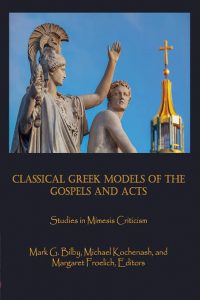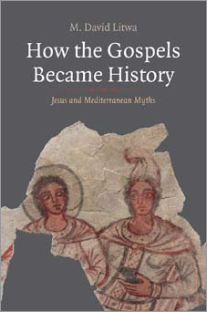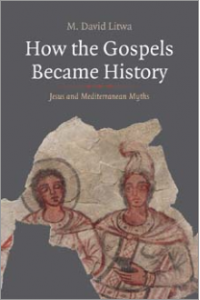I am catching up on too my long-neglected RSS feeds and came across this post from James McGrath: Jesus, James and Peter Mythicism.
It is worth noting precisely what it is that mythicists do with Paul’s references to Jesus in his letters, and just how easily the same could be done with James, the brother of Jesus, whom most mythicists accept was an actual person, while denying that he was actually Jesus’ brother.
Now there is a sweeping confidence about what “mythicists” — a whole block of persons — believe and “precisely” do, or at least “most of them”. Maybe most do. I don’t know. But there are a lot of crackpot mythicists just as there are even more crackpot “Jesus historicists” (usually called fundamentalists, creationists, biblical literalists). Lumping them all together with blanket assertions about what “they” do does not seem like a useful way to open up a discussion.
They emphasize that he is not called “the brother of Jesus” but “the brother of the Lord” as though the Lord, for Paul, were not clearly Jesus. Some have even tried to claim that he was the brother of Yahweh, showing that mythicists are clutching at straws and have no real understanding of what ancient Jews and early Christians believed. (My emphasis)
Again, notice how we begin with the universal “they” and how that elides to “some” but then returns to that same starting point, “the whole bang lot of them”. No need for citations, of course, because the message is that “they all” think and argue the same way. Would McGrath be content if a “mythicist” lumped together all authors of books about the life of Jesus by believers, apologists and others?
“Some have even tried to claim that he was the brother of Yahweh”, writes McGrath. Regretfully he provides no citation. The ones I can recollect who do argue for this do not merely “claim” it; they present a reasoned argument referencing the sources. But let’s move on. The message is that because “some claim” this point it follows that we can see that “mythicists clutch at straws with no real understanding of what ancient Jews and early Christians believed.” “Some” is evidence of what the entire collective is like. (Two points: is McGrath seriously suggesting that “ancient Jews” did not equate Lord with Yahweh, but with Jesus, and that “mythicists” are showing their ignorance on this point? Second point: never mind that the evidence used by that “some” sometimes includes a comparable letter by Paul, the one to the Romans, in which very often, not always, uses “Lord” alone to refer to God, Yahweh, and as a rule makes it explicitly clear whenever he wants us to think that “Lord” applies to Jesus instead. One might be tempted to turn the tables and ask who is showing their lack of “real understanding” of the evidence of what Jews and early Christians believed”.)
And so why don’t they go further still? Paul went up to Jerusalem. Surely this could refer to a heavenly journey to the heavenly Jerusalem, during which he met Jacob, Yahweh’s brother. Simple! After all, Paul himself says that he was taken up to the third heaven.
Perhaps the answer is that mythicists, like McGrath, take the context as a primary pointer to meanings of particular words. Perhaps also because the word for “went up” ἀνῆλθον (anēlthon) is the normal word used for someone traveling up to a town, or a mountain (as in John 6:3) while a “real understanding of what ancient Jews and Christians believed” would inform us that when visionaries “went up” to the heavens they never “walked up” or “went up” as if on a journey of their own: they were seized, grabbed, swept up by an outside force — a different concept and a different word (ἁρπάζω (harpazó) ) is used by Paul to describe his being taken up to the third heaven.
I like reading the works of biblical scholars because I generally have lots to learn from them. I get disillusioned when I find some of them write as if they can get away with spouting misinformation to the generally less informed public.
My objection to this (in case you are starting to think maybe I’m onto something) is that it is the same approach religious fundamentalists take to the text, deciding what it is allowed to mean in advance, and then accepting any interpretation that provides that desired meaning, without discussion or consideration of whether the text more likely means what they think it should. Mythicists prooftext rather than exegete.
Again, where is a citation to support this statement? My own experience has been that I always began with the assumption that James was a real person and that he was believed to have been the brother of Jesus. It never occurred to me — even as an atheist — that Jesus never existed or that there was any reason to question the face-value of this passage in Galatians. It is only on closer examination that some — not all — some mythicists have raised the alternative question. McGrath claims to have read (presumably completely read) Richard Carrier’s book on mythicism, so he knows that Carrier even concludes that this passage in Galatians does indeed add significant weight to the argument for the historicity of Jesus. (The difference between Carrier and McGrath, though, is that Carrier does not turn to this or any other passage as a proof-text and use that one text, like a fundamentalist, to prove a much larger point. Context, and understanding the totality of the writings and manuscript histories are important in any scholarly — genuinely scholarly — analysis.)
I happen to think that the passage does mean exactly what McGrath says it means. I also happen to agree with another author who, in the process of arguing against — against — Jesus mythicism, had the honesty to admit that the patristic history of that passage really does raise serious questions about its authenticity. But that’s a discussion for serious scholarship. I trust McGrath won’t just pooh-pooh those arguments but seriously engage with the evidence as honestly as possible.
No, I am not saying that Howell Smith’s arguments are a slam dunk. There is room for honest doubt and question. What I am saying is that arguments from “proof-texting” — as it seems McGrath is accusing mythicists and of which I believe he himself is guilty — is not the way to go in any serious and informed exploration of the question.
I titled this post “Trumpian response”. I define a “Trumpian” as an attempt to persuade followers through disinformation not to read critical views of his position on things; to persuade followers that all “other views” are by definition “fake news”, and to be ridiculed and rejected out of hand. Certainly, one should never waste time actually reading both sides of a question for oneself and seriously raising the sorts of questions I have raised here among die-hard supporters.











